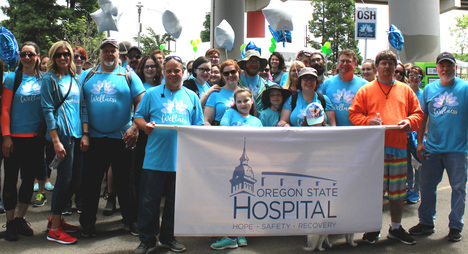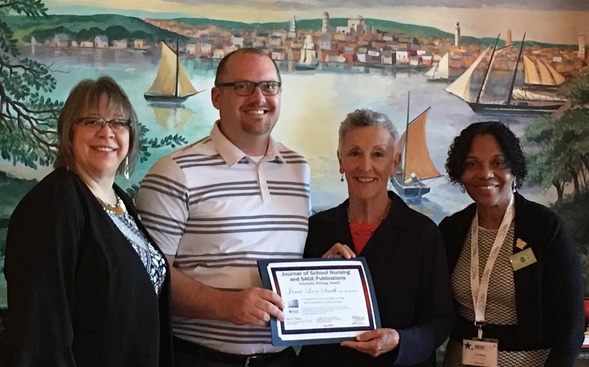July 11, 2018
In this issue ...
  Kweku Wilson speaks at Portland State University commencement.
OHA employee Kweku Wilson received his doctoral degree in June with his dissertation on the relative effectiveness of Oregon’s
patient-centered primary care home (PCPCH) model.
Kweku graduated from the joint Oregon Health & Science
University/Portland State University School of Public Health with a PhD in
Health Systems and Policy. He participated in commencement ceremonies for both
universities last month in Portland and was a student speaker for the PSU
commencement and a standard-bearer for the school of Public Health at the OHSU
ceremony.
Kweku is the Health Care Interpreter program coordinator for
the OHA Office of Equity and Inclusion.
The title of his dissertation is "Health Risks
in Medical Homes and Their Effects on Emergency Department and Inpatient
Expenditures: A Focus on Patient-Centered Primary Care Homes in Oregon."
We asked Kweku five
questions about his research and himself. The answers have been edited for space
considerations.
Q. Can you summarize the focus of your dissertation?
A. It's a relative effectiveness evaluation of PCPCHs based
on the chronic disease burden levels of their patients. My specific interest
was whether PCPCHs that treat higher proportions of chronic care patients
achieved more reductions in emergency department and inpatient expenditures.
The results suggest among others, that savings from emergency department and inpatient
expenditures were higher for low-chronic-disease-burden PCPCHs than high-chronic-disease-burden
PCPCHs.
Q. What implications
does this have for health transformation in Oregon?
A. The traditional
view of the "medical home" model approach to care is that the savings
will come from focusing on high-chronic-disease-burden patients. My research
suggests that this will not be optimal. Instead, broadening the model’s focus
to include both high- and low- chronic disease burden patients could help us to
realize greater savings from ED and IP expenditures. This is obviously only a
short-term study, with data from the first four years of the model's
application.
Q. What's your
educational background?
A. My background is
in public administration and economics. I took some courses in health
administration at PSU and got excited about that and decided to do a PhD. My
parents were health care professionals, so I have always had a fascination
about this field of work. Health reform, including “medical home”
implementation, is going on all around the country, so I decided that looking at
the PCPCH model in Oregon -- an important plank of the state’s health system
reform -- would be interesting. I personally believe that any sustainable
health reform must begin with and emphasize upstream care in primary care
settings.
Q. Tell us a little
bit about yourself.
A. I was born in
Ghana in West Africa. I've been in the Pacific Northwest since 2000. I live in
Longview, Washington, and I like fishing, jogging and reading. I'm a curious
person and interested in learning new things.
Q. What's next, now
that you've finished your PhD?
A. I'm interested in improving access,
affordability and the value of health care services, as well as the goals of
the state’s health system transformation. I’m also curious about how my lived
and learned experience can benefit these processes.

Earlier this week nearly 200
OHA managers met with Director Pat Allen and other senior leaders to learn more
about the OHA Performance System. Part of the meeting involved creating a
fundamentals map that will help employees and managers see the agency’s goals,
along with the processes and measurements that ensure our work aligns with our
goals.
As Director Allen has said at
town halls, the OHA Performance System will bring business rigor to OHA’s
processes and systems, and will increase transparency, accountability and the
wise use of public resources. The Office of Information Services and Oregon
State Hospital have had great success using a performance system. Watch this
brief video to see how a performance system has helped OIS and the hospital
focus on their mission and better serve Oregonians.
  |

Oregon
State Hospital teams raised $5,500 for the National Alliance
on Mental Illness (NAMI) – bringing OSH's seven-year total to about $100,000.
The fundraising helped support the 16th
annual NAMI walk, a mental health awareness event that takes place in 85
locations across the country. About 100 OSH patients, staff and their families
participated in the walks in Portland, Eugene and at a smaller OSH-Salem event,
all on May 20.
The theme for this year’s walk was
“Partners in Wellness.” Jeff Jessel, OSH director of Volunteer Services, said
everyone who participated truly enjoyed the experience – which included
informational booths, an enjoyable route, refreshments and fellowship.
“It was heartwarming to see hundreds of
people, from all walks of life, come together to celebrate recovery and support
those dealing with mental illness,” he said. “The biggest message that we can
learn from this event is that mental illness touches many lives and that
support and awareness are growing.”
This year, about 2,100 people took part
in a NAMI walk in Oregon, raising more than $230,000.
More
information about NAMI is available on its website.
|
 |
The
Health Equity Work Group is one key strategic initiative in the Public Health
Division. This staff-led group advises division leadership on how to increase
cultural responsiveness and build capacity to advance health equity in Oregon
in alignment with Public Health Modernization.
This
work advances Public Health’s foundational capabilities of health equity and
cultural responsiveness. Since its inception in 2016, the workgroup has
increased the division’s focus on health equity, workforce diversity and
community engagement. It has also:
- Created
a conceptual framework for social determinants of health.
- Developed
a library of social determinants of health measures.
- Gathered
recommendations from sections on advancing health equity at the division.
- Facilitated
discussions on how work throughout the division ties to statewide health equity
efforts.
The
25-30 staff members on the work group build the division’s capacity to promote
health equity while sharing best practices from their fields. In the past few
months the group added a full-time staff person, Victoria Demchak, the health equity
coordinator.
The
work group’s priorities are increasing the diversity of the division’s
workforce and establishing stronger relationships with priority populations.
  Jamie Nelson receives the Scholarly Writing Award from the Journal of School Nursing, with (from left): Nina Fekaris, National Association of School Nurses president (and Beaverton school nurse), Julia Cowell, JOSN executive editor, Donna Mazyck, NASN executive director.
An OHA
Public Health staff member received two awards in June that recognize his
dedication and contributions to the school nursing profession.
Jamie
Smith, state school nurse consultant in the Adolescent, Genetic and
Reproductive Health Section's Adolescent and School Health program, received an
Outstanding State School Nurse Consultant Achievement Award from the National Association of State School Nurse Consultants.
He also
accepted the SAGE Scholarly Writing Award from the Journal of School Nursing on
behalf of a research team that published a manuscript about a study on
chocolate milk consumption in an elementary school.
The
manuscript was titled Milk Options
Observations (MOO): A Mixed-Methods Study of
Chocolate Milk Removal on Beverage Consumption and Student/Staff Behaviors in a
Rural Elementary School.
The study,
which was done in 2012 and published in the Journal in 2017, showed that
removal of chocolate milk as a lunch option at the school did not cause a
rebellion among staff or students. It did decrease the consumption of added
sugars without a decline in consumption of calcium and protein.
|







